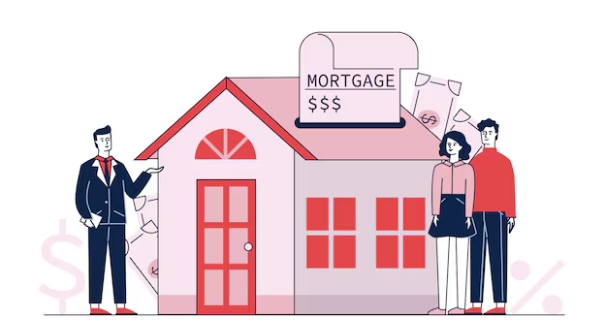Buying a home is one of the most significant financial decisions you’ll ever make, and choosing the right mortgage is a crucial part of that process. With various mortgage options available in the United States, it can be overwhelming to decide which one suits your needs the best.
Each mortgage type has its unique features, benefits, and drawbacks, making it essential to understand them thoroughly before making a commitment. This guide will help you navigate the different mortgage loans available in the USA and determine which one aligns best with your financial situation and long-term goals.
Fixed-rate mortgages: stability for the long haul

Fixed-rate mortgages are one of the most popular types of home loans in the United States, primarily due to their predictability and stability. With a fixed-rate mortgage, your interest rate remains constant throughout the life of the loan, meaning your monthly payments for principal and interest will not change. This can be particularly appealing for first-time homebuyers or those who prefer to budget with certainty over the long term.
One of the main advantages of a fixed-rate mortgage is the protection it offers against inflation and rising interest rates. Even if market rates increase, your mortgage rate stays the same, ensuring that your housing costs remain predictable. This stability can make it easier to plan for other financial goals, such as saving for retirement or paying for education.
However, fixed-rate mortgages tend to have higher initial interest rates compared to adjustable-rate mortgages (ARMs). This can result in higher monthly payments, especially in the early years of the loan. Additionally, if interest rates decrease significantly, you might miss out on potential savings unless you refinance your mortgage. Fixed-rate mortgages are ideal for those who plan to stay in their homes for a long time and prefer the security of a consistent payment.
Adjustable-rate mortgages (ARMs): flexibility with risk
Adjustable-rate mortgages (ARMs) offer an alternative to fixed-rate loans, with interest rates that fluctuate based on market conditions. Typically, ARMs start with a lower interest rate than fixed-rate mortgages, making them an attractive option for borrowers looking for lower initial payments. The interest rate is fixed for an initial period (usually 3, 5, 7, or 10 years), after which it adjusts periodically, often annually.
The main benefit of an ARM is the potential for lower initial payments, which can be especially advantageous for buyers who plan to sell or refinance before the adjustable period begins. During the initial fixed-rate period, borrowers can enjoy lower costs, freeing up money for other expenses or investments. Additionally, if market rates remain low during the adjustable period, the overall cost of the mortgage could be lower than a fixed-rate loan.
However, ARMs come with significant risks. If interest rates rise during the adjustable period, your monthly payments could increase substantially, potentially straining your budget. This unpredictability can be unsettling, especially if your financial situation changes or if you plan to stay in your home longer than initially expected.
FHA loans: government-backed support for first-time buyers
The Federal Housing Administration (FHA) loan is a popular choice for first-time homebuyers or those with less-than-perfect credit. These loans are backed by the government, making them more accessible to borrowers who might not qualify for conventional loans. FHA loans typically require a lower down payment (as low as 3.5%) and have more lenient credit score requirements, making homeownership more attainable for many.
One of the most significant advantages of an FHA loan is the lower down payment requirement. For buyers who struggle to save a substantial down payment, this feature can make the dream of homeownership a reality. Additionally, FHA loans allow for higher debt-to-income ratios, meaning you can qualify with higher existing debt levels compared to conventional loans.
VA loans: exclusive benefits for veterans
VA loans are a unique mortgage option available exclusively to veterans, active-duty service members, and certain members of the National Guard and Reserves. Backed by the Department of Veterans Affairs, these loans offer several benefits, including no down payment, no private mortgage insurance (PMI) requirement, and competitive interest rates. For eligible borrowers, VA loans are one of the most advantageous mortgage options available.
The most significant advantage of a VA loan is the ability to purchase a home with no down payment. This can make homeownership accessible to veterans and service members who might not have substantial savings. Additionally, the absence of PMI, which is typically required for loans with less than a 20% down payment, further reduces the monthly cost of the loan. VA loans also tend to have lower interest rates compared to conventional loans, saving borrowers’ money over the life of the loan.
USDA loans: affordable options for rural homebuyers
USDA loans, backed by the United States Department of Agriculture, are designed to help low-to-moderate-income individuals and families purchase homes in rural areas. These loans offer several attractive benefits, including no down payment and lower interest rates, making homeownership more accessible in rural communities. USDA loans are an excellent option for buyers who meet the income and location requirements.
One of the primary advantages of a USDA loan is the no down payment requirement, similar to VA loans. This can be a significant benefit for buyers who might not have the funds to make a substantial down payment. Additionally, USDA loans often come with lower interest rates compared to conventional loans, reducing the overall cost of homeownership. The government backing also means that lenders are more willing to offer favorable terms to borrowers who might not qualify for other types of loans.
Conclusion: finding the right mortgage for your needs
Choosing the right mortgage loan in the United States requires careful consideration of your financial situation, long-term goals, and the specific features of each loan type. Fixed-rate mortgages offer stability and predictability, making them ideal for those planning to stay in their homes for the long term. ARMs provide flexibility and lower initial payments but come with the risk of rising rates.
FHA loans are excellent for first-time buyers with lower credit scores, while VA loans offer unparalleled benefits for veterans and service members. USDA loans provide affordable options for rural homebuyers, with no down payment and lower interest rates.





